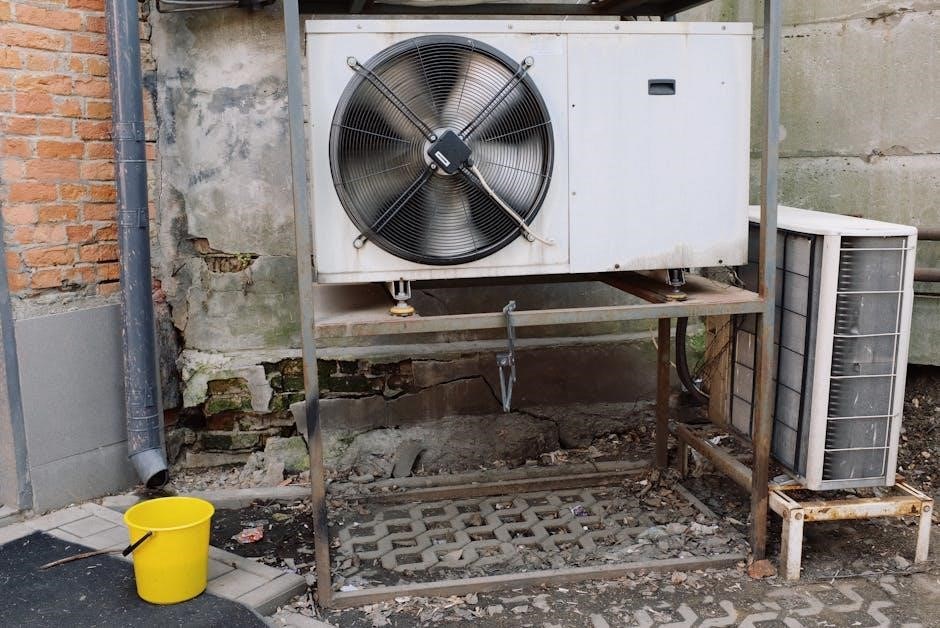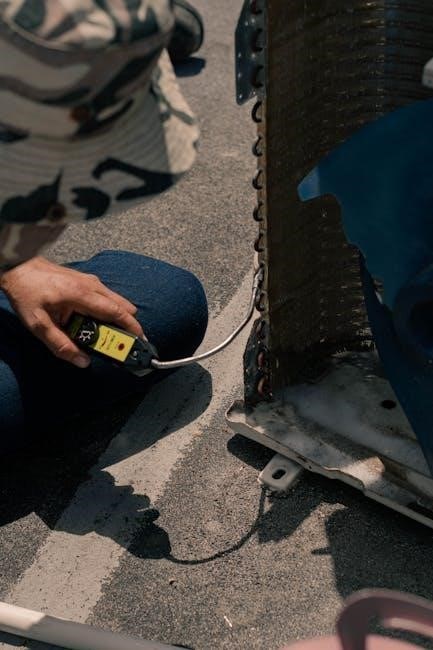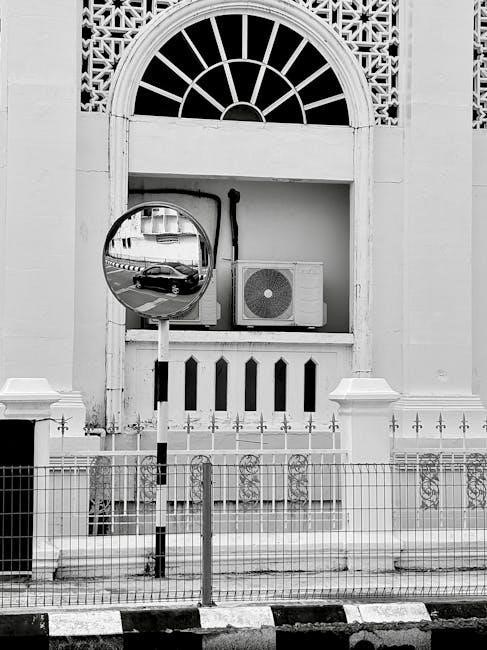This guide provides essential tips and solutions for common Lennox air conditioner issues, helping you identify problems and fix them efficiently, whether through DIY solutions or professional assistance.
Understanding the Importance of Regular Maintenance
Regular maintenance is crucial for ensuring your Lennox air conditioner operates efficiently and lasts longer. Cleaning filters, inspecting coils, and checking airflow can prevent common issues. Neglecting maintenance may lead to reduced cooling performance, higher energy bills, or system breakdowns. Scheduling annual tune-ups helps maintain optimal performance and addresses potential problems early.

Key Components of a Lennox Air Conditioner
A Lennox air conditioner consists of essential components like the compressor, refrigerant, coils, fan motor, thermostat, and air filters, all working together to ensure efficient cooling and airflow.
The Compressor: Heart of the System
The compressor is the core of your Lennox air conditioner, pressurizing and circulating refrigerant through the system. It ensures efficient heat transfer and cooling. If it overheats or fails, the entire system can malfunction. Regular maintenance is crucial to prevent issues and extend its lifespan.
Refrigerant and Coils: Essential for Heat Transfer
The refrigerant and coils are vital for heat transfer in your Lennox AC. Refrigerant absorbs heat from indoor air, while coils dissipate it outside. Leaks, low refrigerant levels, or dirty coils can disrupt this process, reducing efficiency. Regular cleaning and inspections are crucial to maintain optimal performance and prevent system failures.
Fan Motor and Blower: Ensuring Proper Airflow
The fan motor and blower are critical for circulating air through your Lennox AC system. Issues like worn bearings, dust buildup, or motor failure can disrupt airflow, leading to reduced cooling and increased energy bills. Regular maintenance, such as cleaning and lubricating, can help prevent these problems and maintain efficient operation.
Thermostat and Controls: Regulating Temperature
The thermostat and controls are essential for maintaining your desired temperature. Issues like dead batteries, incorrect settings, or malfunctioning sensors can prevent your Lennox AC from cooling properly. Ensuring the thermostat is set correctly and functioning well is a key step in troubleshooting and optimizing your system’s performance for consistent comfort.
Air Filters and Vents: Maintaining Efficiency
Clean air filters and unobstructed vents are crucial for your Lennox AC’s efficiency. Dirty filters reduce airflow, while blocked vents can cause poor performance. Regularly inspect and clean filters, and ensure vents are clear of debris or furniture to maintain optimal airflow and system efficiency, preventing common issues like reduced cooling or increased energy use.

Common Issues and Solutions
Lennox air conditioners may face issues like not cooling, failing to start, or making strange noises. These problems often stem from dirty filters, blocked vents, or refrigerant leaks, which can typically be resolved with simple troubleshooting steps and regular maintenance.
Unit Not Blowing Cold Air: Possible Causes and Fixes

A Lennox AC not blowing cold air may be due to a dirty air filter, low refrigerant, or blocked condenser coils. Check and clean filters, ensure refrigerant levels are adequate, and clear debris from coils. Also, verify thermostat settings and ensure vents are unobstructed. If issues persist, professional assistance may be needed to address internal component malfunctions.
AC Not Turning On: Troubleshooting Steps
If your Lennox AC won’t turn on, check the power supply, circuit breakers, and fuses. Ensure the thermostat is set correctly and batteries are fresh. Verify that the air filter is clean and vents are unobstructed. If issues persist, inspect the outdoor unit for blockages or damage. Professional help may be needed for internal electrical or component failures.
Strange Noises: Identifying the Source
Strange noises from your Lennox AC may indicate underlying issues. Rattling sounds could signal loose parts or debris, while hissing might point to a refrigerant leak. Clunking or screeching noises often suggest a failing fan motor or compressor. Turn off the unit and inspect for obstructions or damage. Contact a professional if the issue persists or worsens.
Water Leaks: Addressing Condensate Issues
Water leaks from your Lennox AC are often caused by condensate drain line blockages or improper installation. Check for clogged drains and ensure the condenser is level; A dirty air filter or low refrigerant levels can also cause excessive condensation. Clean or replace filters and inspect the drain line for obstructions to resolve the issue.
Drainage Problems: Clearing Blockages
Drainage issues in Lennox ACs often stem from blockages in the condensate drain line. Algae, dirt, or debris can cause these clogs. Regularly inspect and clean the drain line, ensuring it’s free of obstructions. Check for kinks or misalignment and correct them. If problems persist, consider consulting professional assistance to avoid water damage or system shutdowns.

Simple DIY Troubleshooting Steps
Simple DIY troubleshooting steps for your Lennox AC include checking thermostat settings, inspecting air filters, ensuring vents are clear, verifying power supply, and resetting the unit.
Checking the Thermostat Settings
Ensure your Lennox thermostat is set to “COOL” mode and the desired temperature is correctly set. Verify that the thermostat is not in “HEAT” mode by mistake. For wireless models, check the battery levels and replace them if necessary. A malfunctioning thermostat can prevent your AC from cooling properly, so this is a critical first step in troubleshooting.
Inspecting and Cleaning Air Filters
Locate and inspect your Lennox air conditioner’s air filters, typically found in the indoor unit or return air ducts. Clean or replace them if dirty, as clogged filters reduce airflow and efficiency. Check filters monthly and clean or replace them every 1-3 months, depending on usage. Refer to your owner’s manual for specific guidance.
Ensuring Vents Are Clear
Ensure all air vents and registers in your home are unobstructed by furniture or debris to maintain proper airflow. Clearing blockages allows your Lennox air conditioner to operate efficiently, preventing issues like uneven cooling or increased energy bills.
Verifying Power Supply and Circuit Breakers
Check that your Lennox air conditioner’s power supply is stable and circuit breakers are not tripped. Ensure the unit is properly plugged in and no fuses are blown. A loss of power is a common issue that can be resolved by verifying electrical connections and resetting circuit breakers if necessary.
Resetting the Air Conditioner
Resetting your Lennox air conditioner can often resolve issues like the unit not cooling or malfunctioning. Locate the reset button on the control panel, press and hold it for a few seconds, then release. This action restarts the system, potentially fixing minor glitches. If the issue persists, further troubleshooting or professional assistance may be required.

When to Call a Professional
Call a professional if your Lennox AC shows signs of major component failure, refrigerant leaks, or complex electrical issues that require specialized tools and expertise to resolve safely and effectively.
Recognizing Signs of Major Component Failure
Watch for unusual noises, excessive vibration, or reduced airflow, as these may indicate failing compressors, fan motors, or coils. If your Lennox AC exhibits these symptoms, it’s crucial to call a professional to prevent further damage and costly repairs.
- Unusual grinding or screeching noises
- Visible vibrations or shaking
- Reduced or no airflow
- Complete system shutdown
Addressing these issues promptly ensures your system operates efficiently and safely.
Dealing with Refrigerant Leaks
Refrigerant leaks can cause your Lennox AC to blow warm air or struggle to cool. If you suspect a leak, turn off the unit and contact a professional immediately. Refrigerant handling requires specialized tools and training, and improper disposal can harm the environment. Only licensed HVAC technicians should address this issue to ensure safe and effective repairs.
Addressing Complex Electrical Issues
Complex electrical issues, such as faulty wiring, blown fuses, or capacitor failure, require immediate attention. These problems can disrupt your Lennox AC’s operation and pose safety risks. Always contact a certified HVAC technician, as DIY repairs can be dangerous and may lead to further damage or safety hazards. Professional expertise ensures proper diagnosis and safe resolution.

Regular Maintenance Tips
Regular maintenance ensures optimal performance and extends the lifespan of your Lennox air conditioner. Clean coils, inspect filters, and schedule annual tune-ups to maintain efficiency and prevent issues.
Cleaning Coils and Condensers
Cleaning your Lennox air conditioner’s coils and condensers is crucial for maintaining efficiency. Dirty coils can reduce cooling performance and increase energy costs. Use a garden hose to gently clean the condenser coils, and ensure the area around the unit is free from debris. Regular cleaning prevents issues like poor airflow and system overheating, ensuring optimal performance and longevity.
Scheduling Annual Tune-Ups
Scheduling annual tune-ups for your Lennox air conditioner ensures optimal performance and prevents potential breakdowns. A professional technician will inspect and clean components, check refrigerant levels, and verify proper airflow. Regular maintenance enhances energy efficiency, reduces operational costs, and extends the system’s lifespan, keeping your home comfortable year-round.

How to Reset a Lennox Air Conditioner
Resetting your Lennox air conditioner can resolve common issues. Locate the reset button on the control panel and press it firmly to restore default settings and restart the system.
Locating the Reset Button
The reset button on a Lennox air conditioner is typically found on the control panel or near the compressor. It may be labeled as “Reset” or have a designated symbol. Refer to your unit’s manual or manufacturer’s instructions for exact location details to ensure proper operation and avoid unnecessary repairs.
Performing a System Reset
Press and hold the reset button for 10-15 seconds, then release. Ensure the system is turned off before resetting. Wait 30 minutes for the system to restart. If issues persist, contact a professional for further assistance. This simple step can resolve many common operational problems effectively.

Lennox Troubleshooting Resources
Lennox offers a troubleshooting tool and product literature lookup to help identify and fix issues. These resources provide detailed guides and manuals for DIY fixes and professional assistance.
Using the Lennox Troubleshooting Tool

The Lennox Troubleshooting Tool is an online resource designed to help users identify and resolve common issues with their air conditioners. By entering specific error codes or symptoms, users can access detailed repair guidance, recommended solutions, and parts information. This tool simplifies the diagnostic process, empowering homeowners to address problems confidently and efficiently.
Accessing Product Manuals and Literature
Lennox provides comprehensive product manuals and literature to help users troubleshoot and maintain their air conditioners. These resources, available on the Lennox website, include detailed guides, parts lists, and model-specific instructions. Accessing this literature ensures accurate troubleshooting and repair, helping homeowners address issues effectively and maintain their system’s optimal performance.
By following this guide, you can maximize your Lennox air conditioner’s efficiency, ensure reliable performance, and prolong its lifespan through effective troubleshooting and regular maintenance.
Maximizing Efficiency and Longevity
Regular maintenance is key to ensuring your Lennox air conditioner runs efficiently and lasts longer. Clean filters, inspect coils, and check thermostat settings to optimize performance. Schedule annual tune-ups with professionals to address potential issues early and prevent major repairs, ensuring your system operates smoothly for years to come.